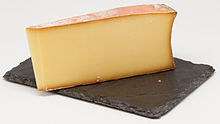Abondance (cheese)
The Abondance is a French semi-hard cheese made from raw milk . Abondance has been a protected designation of origin since 1996 , and production may only take place in selected municipalities in the Haute-Savoie department . The cheese has at least 48 percent fat in the dry matter .
properties
A loaf of Abondance is 38 to 43 centimeters in diameter and seven to eight centimeters high. It weighs between seven and 12 kilograms and has a characteristic concave edge and golden yellow to brown rind. The batter is cream-colored to pale yellow, with small and well-spaced holes, and has a resilient, fine-grain texture. The cheese must contain at least 48 percent fat in the dry matter , the moisture content of the cheese must not exceed 42 percent.
history
In the 12th century, the Augustinian monks of the Abondance monastery started making cheese. The literature states that the Abondance was served at the Avignon Conclave in 1381. This legend does not stand up to critical scrutiny. Avignon was home to the papal court for a long time during the fourteenth century and the majority of cardinals lived there. The election of Pope Urban VI. however, took place again in Rome in 1378. In the same year the antipope Clement VII was elected in Fondi , who resided in Avignon. First Clemens' successor, Benedict XIII. , was elected in Avignon in 1394.
In 1990 the name Abondance was protected as an Appellation d'Origine Contrôlée (AOP). In 1996 Abondance became a protected designation of origin . This is linked to specifications for the production of the cheese. The main limitation associated with this is the definition of the production area in most of the Haute-Savoie department . The ordinance lists the cantons and communes in which Abondance may be produced by name. The cheese may only be made from raw milk from cows of the Abondance , Montbéliard and Tarenteser breeds (also known as Tarine). From 2022, a farm that produces milk for Abondance must consist of at least 55 percent cows of the Abondance breed. The cows must be grazed on at least 150 days a year. They are not allowed to be fed with silage and at least 65 percent of the feed must come from the designated production area. The milk from two consecutive milkings in the evening and the following morning still has to be processed by the morning of the second day.
The Abondance is produced in different types of manufacturing plants, each of which is subject to special regulations. If the requirements are met, it may be marketed with the additional designation fermier or alpage :
- fermier , produced on a farm, the cheese wheels have a green, oval label. The milk must come from their own farm and 45 percent from Abondance cows. The milk from two consecutive milkings is processed no later than 14 hours after the first milking. Some production steps have to be done by hand in the traditional way, such as dividing the curd with a cheese harp and transferring the curds for each individual cheese into the mold with a cheese cloth . The loaves must be turned once within half an hour after being placed in the molds and at least twice during the following twelve hours. In 2014, around 65 companies were certified to produce Abondance.
- alpage , the cheese is only produced in the summer months. Its milk comes from cows that are kept on pastures at an altitude of 1300 to 1385 meters.
- laitier or fruitière , the loaves have red, square labels on them. In 2014 there were around 15 cooperatives that obtain their milk from up to 200 dairy farms.
In 2014 about 2,400 tons of Abondance were produced, of which about 800 tons were fermier .
Manufacturing
Abondance is traditionally produced in an open copper kettle , until 2021 stainless steel tanks that were put into operation in 2006 or earlier may be used. The raw milk is heated to 30 to 35 ° C, then rennet and a specific starter culture from thermophilic bacteria, Streptococcus thermophilus , Lactobacillus delbrueckii subsp. bulgaricus and Lactobacillus helveticus . After curdling , the curd is cut into pieces of a maximum of one cubic centimeter with a cheese harp and heated again, this time for at least 40 minutes to a temperature of 45 to 50 ° C. The curd is then skimmed off and poured into linen-lined molds, in which it is pressed for at least seven hours in order to obtain the typical surface structure. After draining, the cheeses are stored in ripening rooms at a temperature of 10 to 13 ° C and a humidity of at least 90 percent on unplaned spruce boards. During the ripening process, which takes at least a hundred days and up to twelve months, the loaves are turned over and over and rubbed with salt to achieve the thin yellowish to reddish brown rind.
consumption
Often eaten as a multi-course dessert after a meal, abondance goes well on a cheese platter. It is the main ingredient of the Sayoyardian appetizer Berthoud, a gratinated cheese that is served with jacket potatoes and a white wine from the region.
Web links
- La Société Secrète: Fromage Abondance (French)
- Deutschlandradio: Abondance, a ski resort without winter.
Individual evidence
- ↑ a b c d e f Eric Beuvier, Juliet Harbutt: Abondance . In: Catherine Donnelly (Ed.): The Oxford Companion to Cheese . Oxford University Press, Oxford 2016, ISBN 978-0-19-933088-1 , pp. 1-3 .
- ↑ a b c d Décret n ° 2007-949 from May 15, 2007 related to l'appellation d'origine contrôlée "Abondance" . May 15, 2007 ( gouv.fr ).
- ↑ Commission Regulation (EC) No. 1107/96 of June 12, 1996 on the registration of geographical indications and designations of origin in accordance with the procedure under Article 17 of Council Regulation (EEC) No. 2081/92 , accessed on January 26, 2020

